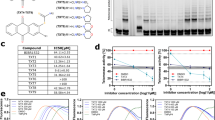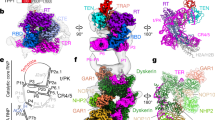Abstract
Aim:
To examine the ability of rapamycin to suppress growth and regulate telomerase activity in the human T-cell leukemia cell line Jurkat.
Methods:
Cell proliferation was assessed after exposure to rapamycin by 3-(4,5-dimethylthiazol-2-yl)-2,5-diphenyltetrazolium bromide assay. Cell cycle progression and apoptosis were determined by flow cytometry. The proteins important for cell cycle progression and Akt/mammalian target of rapamycin signaling cascade were assessed by Western blotting. Telomerase activity was quantified by telomeric repeat amplication protocol assay. The human telomerase reverse transcriptase (hTERT) mRNA levels were determined by semi-quantitative RT-PCR.
Results:
Rapamycin inhibited the proliferation of Jurkat, induced G1 phase arrest, unregulated the protein level of p21 as well as p27, and downregulated cyclinD3, phospho-p70s6k, and phospho-s6, but had no effect on apoptosis. Treatment with rapamycin reduced telomerase activity, and reduced hTERT mRNA and protein expression.
Conclusion:
Rapamycin displayed a potent antileukemic effect in the human T-cell leukemia cell line by inhibition of cell proliferation through G1 cell cycle arrest and also through the suppression of telomerase activity, suggesting that rapamycin may have potential clinical implications in the treatment of some leukemias.
Similar content being viewed by others
Article PDF
References
Dennis PB, Jaeschke A, Saitoh M, Fowler B, Kozma SC, Thomas G . Mammalian TOR: a homeostatic AT P sensor. Science 2001; 294: 1102–5.
Schmelzle T, Hall MN . TOR, a central controller of cell growth. Cell 2000; 103: 253–62.
Panwalkar A, Verstovsek S, Giles FJ . Mammalian target of rapamycin inhibition as therapy for hematologic malignancies. Cancer 2004; 100: 657–66.
Follo MY, Mongiorgi S, Bosi C, Cappellini A, Finelli C, Chiarini F . The Akt/mammalian target of rapamycin signal transduction pathway is activated in high-risk myelodysplastic syndromes and influences cell survival and proliferation. Cancer Res 2007; 67: 4287–94.
Mayerhofer M, Aichberger KJ, Florian S, Krauth MT, Hauswirth AW, Derdak S, et al. Identification of mTOR as a novel bifunctional target in chronic myeloid leukemia: dissection of growth-inhibitory and VEGF-suppressive effects of rapamycin in leuke-mic cells. FASEB J 2005; 19: 960–2.
Martelli AM, Tazzari PL, Evangelisti C, Chiarini F, Blalock WL, Billi AM, et al. Targeting the phosphatidylinositol 3-kinase/Akt/mammalian target of rapamycin module for acute myelogenous leukemia therapy: from bench to bedside. Curr Med Chem 2007; 14: 2009–23.
Deville L, Hillion J, Lanotte M, Rousselot P, Segal Bendirdjian E. Diagnostics, prognostic and therapeutic exploitation of telomeres and telomerase in leukemias. Curr Pharm Biotechnol 2006; 7: 171–83.
Kubuki Y, Suzuki M, Sasaki H, Toyama T, Yamashita K, Maeda K, et al. Telomerase activity and telomere length as prognostic factors of adult T-cell leukemia. Leuk Lymphoma 2005; 46: 393–9.
Kang, SS, Kwon T, Kwon DY, Do SI . Akt protein kinase enhances human telomerase activity through phosphorylation of telomerase reverse transcriptase subunit. J Biol Chem 1999; 274: 13085.
Lei W, Liu F, Ness SA . Positive and negative regulation of c-Myb by cyclin D1, cyclin-dependent kinases, and p27 Kip1. Blood 2005; 105: 3855–61.
Sekulic A, Hudson CC, Homme JL, Yin P, Otterness DM, Karnitz LM, et al. A direct linkage between the phosphoinositide 3-kinase-AKT signaling pathway and the mammalian target of rapamycin in mitogen-stimulated and transformed cells. Cancer Res 2000; 60: 3504–13.
Brown EJ, Beal PA, Keith CT, Chen J, Shin TB, Schreiber SL . Control of p70 s6 kinase by kinase activity of FRAP in vivo. Nature 1995; 377: 441–6.
Jefferies HB, Fumagalli S, Dennis PB, Reinhard C, Pearson RB, Thomas G . Rapamycin suppresses 5′TOP mRNA translation through inhibition of p70s6k. EMBO J 1997; 16: 3693–704.
Kyo S, Kanaya T, Takakura M, Tanaka M, Inoue M . Human telomerase reverse transcriptase as a critical determinant of telomerase activity in normal and malignant endometrial tissues. Int J Cancer 1999; 80: 60–3.
Gokbuget N, Hoelzer D . Recent approaches in acute lymphoblastic leukemia in adults. Rev Clin Exp Hematol 2002; 6: 114–41.
West KA, Castillo SS, Dennis PA . Activation of the PI3K/Akt pathway and chemotherapeutic resistance. Drug Resistance Updates 2002; 5: 234–48.
Rowinsky EK . Targeting the molecular target of rapamycin (mTOR). Curr Opin Oncol 2004; 16: 564–75.
Baldin V, Lukas J, Marcote MJ, Pagano M, Draetta G . Cyclin D1 is a nuclear protein required for cell cycle progression in G1. Genes Dev 1993; 7: 817–21.
Weinberg RA . The retinoblastoma protein and cell cycle control. Cell 1995; 81: 323–30.
Polyak K, Lee MH, Erdjument-Bromage H, Koff A, Roberts JM, Tempst P, et al. Cloning of P27kip1, a cyclin-dependent kinase inhibitor and potential mediator of extracellular antimitogenic signals. Cell 1994; 78: 59–66.
Toyoshima H, Hunter T . p27, a novel inhibitor of G1 cyclin-Cdk protein kinase activity, is related to p21. Cell 1994; 78: 67–74.
Sarbassov DD, Ali SM, Sengupta S, Sheen JH, Hsu PP, Bagley AF, et al. Prolonged rapamycin treatment inhibits mTORC2 assembly and Akt/PKB. Mol Cell 2006; 22: 159–68.
Hidalgo M, Rowinsky EK . The rapamycin-sensitive signal trans-duction pathway as a target for cancer therapy. Oncogene 2000; 19: 6680–6.
Bae-Jump VL, Zhou C, Gehrig PA, Whang YE, Boggess J F . Rapamycin inhibits hTERT telomerase mRNA expression, independent of cell cycle arrest. Gynecol Oncol 2006; 100: 487–94.
Feng J, Funk WD, Wang SS, Weinrich SL, Avilion AA, Chiu CP, et al. The RNA component of human telomerase. Science 1995; 269: 1236–41.
Nakamura TM, Morin GB, Chapman KB, Weinrich SL, Andrews WH, Lingner J, et al. Telomerase catalytic subunit homologs from fission yeast and human. Science 1997; 277: 955–9.
Bodnar AG, Ouellette M, Frolkis M, Holt SE, Chiu CP, Morin GB, et al. Extension of life-span by introduction of telomerase into normal human cells. Science 1998; 279: 349–52.
Stewart SA, Weinberg RA . Telomerase and human tumorigenesis. Semin Cancer Biol 2000; 10: 399–406.
Cong YS, Wright WE, Shay JW . Human telomerase and its regulation. Microbiol Mol Biol Rev 2002; 66: 407–25.
Hudson CC, Liu M, Chiang GG, Otterness DM, Loomis DC, Kaper F, et al. Regulation of hypoxia-inducible factor 1alpha expression and function by the mammalian target of rapamycin. Mol Cell Biol 2002; 22: 7004–14.
Bruemmer D, Yin F, Liu J, Kiyono T, Fleck E, Va n Herle AJ, et al. R a pa mycin inhibits E2 F-dependent expression of minichromosome maintenance proteins in vascular smooth muscle cells. Biochem Biophys Res Commun 2003; 303: 251–8.
Hay N, Sonenberg N . Upstream and downstream of mTOR. Genes Dev 2004; 18: 1926–45.
Nishi H, Nakada T, Kyo S, Inoue M, Shay JW, Isaka K . Hypoxia-inducible factor 1 mediates upregulation of telomerase (hTERT). Mol Cell Biol 2004; 24: 6076–83.
Zhu X, Kumar R, Mandal M, Sharma N, Sharma HW, Dhingra U, et al. Cell cycle-dependent modulation of telomerase activity in tumor cells. Proc Natl Acad Sci USA 1996; 93: 6091–5.
Lee SH, Kim JW, Oh SH, Kim YJ, Rho SB, Park K, et al. IFN-gamma/IRF-1-induced p27kip1 down-regulates telomerase activity and human telomerase reverse transcriptase expression in human cervical cancer. FEBS Lett 2005; 579: 1027–33.
Author information
Authors and Affiliations
Corresponding author
Additional information
Project funded by grants from the Chinese 973 project (No 2002CB713700) and the National Natural Science Foundation of China (No 30570941).
Rights and permissions
About this article
Cite this article
Zhao, Ym., Zhou, Q., Xu, Y. et al. Antiproliferative effect of rapamycin on human T-cell leukemia cell line Jurkat by cell cycle arrest and telomerase inhibition. Acta Pharmacol Sin 29, 481–488 (2008). https://doi.org/10.1111/j.1745-7254.2008.00767.x
Received:
Accepted:
Issue Date:
DOI: https://doi.org/10.1111/j.1745-7254.2008.00767.x
Keywords
This article is cited by
-
Combining old and new concepts in targeting telomerase for cancer therapy: transient, immediate, complete and combinatory attack (TICCA)
Cancer Cell International (2023)
-
Effect of rapamycin treatment in human seminoma TCam-2 cells through inhibition of G1-S transition
Naunyn-Schmiedeberg's Archives of Pharmacology (2023)
-
MNK1 inhibitor CGP57380 overcomes mTOR inhibitor-induced activation of eIF4E: the mechanism of synergic killing of human T-ALL cells
Acta Pharmacologica Sinica (2018)
-
Targeting the PI3K/Akt/mTOR signaling pathway in B-precursor acute lymphoblastic leukemia and its therapeutic potential
Leukemia (2014)
-
Different responses of cell cycle between rat vascular smooth muscle cells and vascular endothelial cells to paclitaxel
Journal of Huazhong University of Science and Technology [Medical Sciences] (2014)



